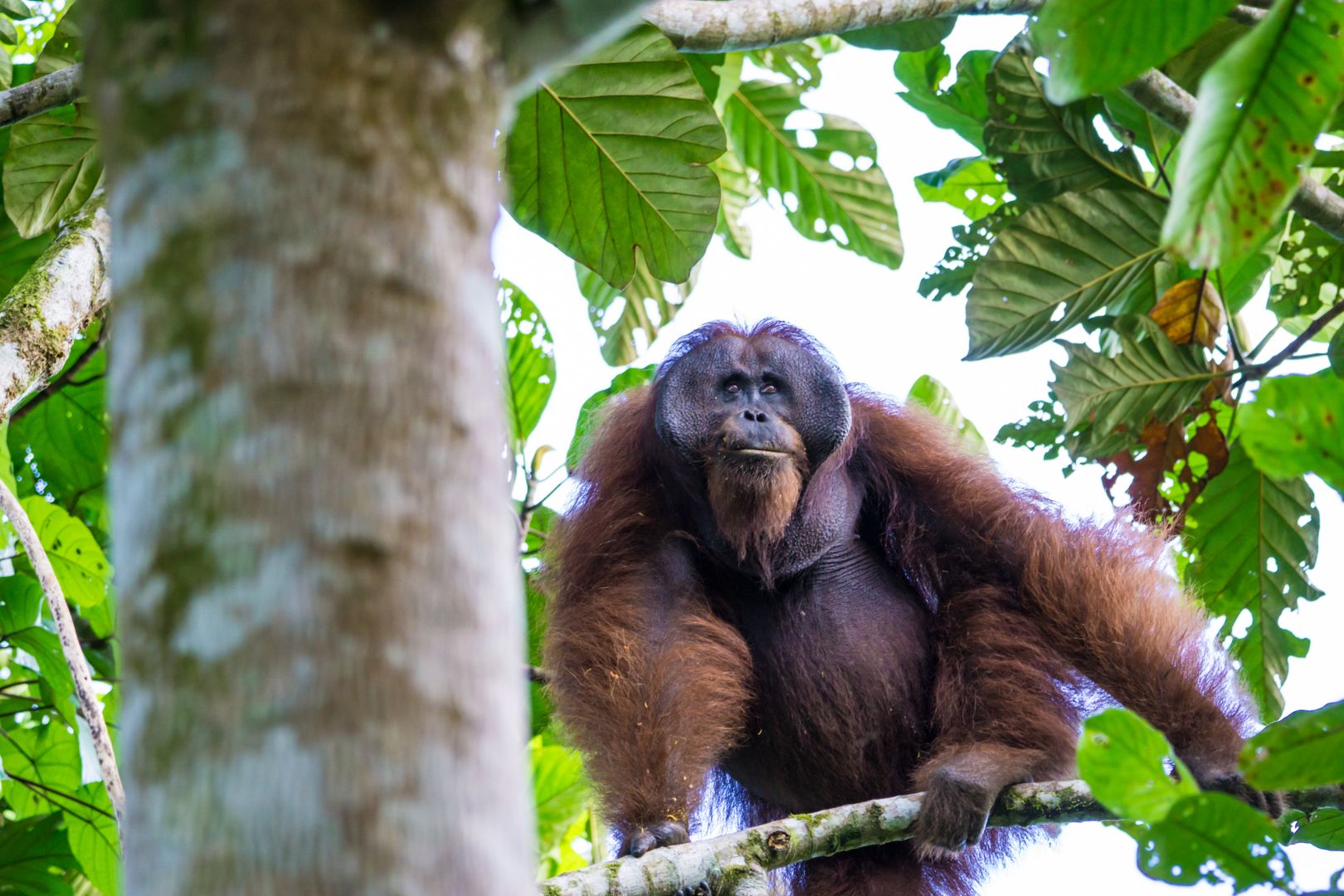
Orangutan in Borneo
Orangutan simply means “Person of the Jungle” in the Malay language. Orangutan belong to the Great Apes family joining the primates of Gorillas, Bonobo and Chimpanzees, where non have tails. They have proportionally long and strong arms which helps them a lot to swing from one branch to the other. The orangutan legs are short, and they have beautiful russet shaded hair. As the male orangutan becomes an adult, it will develop distinctive cheek pads or flanges. Vocally they make long calls to attract the female orangutan or to intimidate rivals. The younger male orangutan do not make such calls and almost replicate the features of an adult female.
During the Pleistocene, the Orangutan population was once spread across the forests of Southeast Asia and South China. However, today orangutans are only found in the islands of Sumatra and Borneo.
Orangutan Species:
Bornean Orangutan (Pongo pygmaeus)
is further divided into the following subspecies
- Pongo pygmaeus pygmaeus – northwest populations
- Pongo pygmaeus morio – east populations
- Pongo pygmaeus wurmbii – southwest populations
The Bornean Orangutan are endemic to the island of Borneo in both Malaysian states of Sabah and Sarawak as well as North, East, Central and West Kalimantan.
The Bornean Orangutan differs in appearance compared to the Sumatran orangutan, with a much broader face, shorter beard and slightly darker in colour.
The Bornean orangutan spends most of its time on trees but do move on the ground to move between stands of trees. This behaviour hardly happens with the Sumatran Orangutan and believed to be linked to sharing its habitat with the Sumatran tiger.
Sumatran Orangutan (Pongo abelii)
The Sumatran orangutan are found only in the north of the Indonesian Island of Sumatra and is endemic in the north of Sumatra.
The Sumatran orangutan can be distinguished from their longer facial hair, slightly smaller face, much thinner and have closer social bond compared to the Bornean orangutan. The Sumatran orangutan community is does not show social or spatial exclusivity and can be seen gathering in groups to feed on fruit trees.
Tapanuli Orangutan (Pongo tapanuliensis)
The Tapanuli orangutan is the uncommon of all great apes discovered in 1997 during an orangutan survey. This orangutan breed lives in North Sumatra with only 800 or fewer individuals left. This makes it the most endangered Great Ape species in the world. The Tapanuli orangutan have smaller heads, frizzier hair with flatter and wider face compared to the Bornean and Sumatran orangutan. The Tapanuli orangutan is endemic to 475 square miles of upland forest in the Batang Toru Ecosystem in Sumatra and is believed to have been isolated from other orangutan population for more 10,000 years (WWF, 2017).
Orangutans Character and Behaviour
Orangutans are highly intelligent with great memories as they roam the rainforest and consequently makes mental maps of their home in order to look for food source throughout the seasons. A typical day for the orangutan is spent on travelling, feeding and resting.
Orangutans Diet
Orangutan spends most of its time foraging for fruit and leaves. Figs, durian, jackfruit are highly favoured. They are not entirely vegans as part of their diet include bird eggs, insects, bark, honey and small vertebrates such as the cute slow loris. Depending on geographical location, the orangutans may also consume soil and other earth substances such as those created by termites. They are also known to pay visit mineral licks at the clay or sandstone-like walls of cliffs. The soils contain high concentration of kaolin which counteracts toxic tannins and phenolics acids found in the orangutan diet (Rijksen H. D.; Meijaard, E. (1999)
Orangutan Nest
Orangutans are creatures of comfort. They would need a new nest on daily basis. Selective as to where the nest should be built for its day or night rest, the orangutan are careful with the construction of their nest, a trait they pick up by observing their mother’s nest building. As young as six months of age, orangutan practice nest building using smaller, leafy branches and huge leaves for protection against rain or sun. By the time the orangutan reaches three years of age, they would have already and gain proficiency at nest building.
Orangutan Life Cycle
Orangutan takes a long time to grow and breed even slower than any other primates. The gestation period of a baby orangutan is approximately eight and half months. Though the orangutans are not so sociable among its orangutan community, the bond between a mother and baby orangutan is as solid as a rock. The father orangutan plays no role in this upbringing.
A new born baby orangutan weighs about 1.5kg and are dependent on its mother for at least five years as it carefully observes and studies the ropes of life to survive in the forest. The first two years the baby orangutan is completely attached to its mother. It would cling on its mother’s stomach, side and back and enjoy being swung from tree to tree and feed on breast milk. Breastfeeding may continue till the offspring reaches 8 years old and it remains close to its mother until it is about 10 years of age.
Wild female orangutans becomes sexually active at 12 years of age. However, they will only have their first offspring at 15 -16 years of age. The gestation period of a baby orangutan is about eight and half months. The female orangutan will have an offspring on average only once every 7 to 8 years and they will usually have no more than 3 offspring in its lifetime. Orangutans in general live around 45 years in the wild and more than 30 years in captivity.
This goes to say that with the slow and infrequent reproduction of offspring combined with habitat loss and threats, the orangutan population grow at an extremely slow pace.
Bornean Orangutan in the forest
The Bornean orangutan inhibits the tropical rainforests of Borneo both within the borders of Sabah and Sarawak in Malaysia as well as in Kalimantan provinces of Indonesia. Most of their lives are spent in the trees especially with lowland dipterocarp and old secondary forests.
The forest is the nomadic orangutan built a new nest daily – usually 15 to 100 feet up in a tree. The forest offers the orangutans’ playground and food source. Over 90% of the food orangutans eat are found in the canopies of the forest. The orangutans are also known as the real gardener of the forest. This durian lover ape plays a vital role at dispersing seeds to maintain healthy forest ecosystem.
The scenario above sounds great and harmonious as it should be isn’t it? Well this is often not the case……
Deforestation and Orangutan
Sadly, deforestation driven by economic means, which includes logging and oil palm is the main cause to habitat loss for the orangutan and other wildlife. Of course, draught driven forest fire plus irresponsible act of human that led to forest fire that contributes to the fact that these poor orangutans are pushed at the brink of extinction.
About 10 decades ago, there were 315,000 orangutans in the wild. Between 1999 to 2015, 150,000 Bornean orangutans have been lost over the period of 16 years (BBC News, 2018). At present time, the Borneo orangutan is estimated at about 104,700 individuals (endangered), Sumatran orangutan about 7500 individuals (critically endangered) and Tapanuli orangutan about 800 individuals left (most endangered). In Sabah the Borneo orangutan are estimated about 11,000 individuals (wwf, 2018).
Threats Orangutan face
All the three species of orangutans – Bornean orangutan, Sumatran orangutans and Tapanuli orangutans are highly endangered due to deforestation, forests fire and poaching for illegal pet trade. Orangutans not only lost their habitat but are also killed by villagers when they raid agricultural areas for food.
Orangutan may also be killed for bushmeat trade. Some locals are motivated to kill orangutans on the grounds of self-defence and some for economical means – kill the mother orangutans so the infant can be sold in the exotic pet trade. Many of the infant die without the presence of its mother.
Reforestation for the orangutan in Sabah.
Between the 1980s to early 2000s the orangutan habitat alarmingly decreased due to logging, forest fires and forest fragmentation by roads. Total estimated orangutan in Sabah are estimated about 11,000 individuals making Sabah one of the main strongholds for orangutan in North Borneo.
Much damaged has been done by us human at the expense of the orangutan livelihood and survival. NGOs such as WWF has introduced good move towards reforestation to return the habitat back to the orangutan. The WWF and Sabah Forestry efforts at tree planting in 2007 at Bukit Piton Forest Reserve in Lahad Datu, Sabah for example indicated that restoring a degraded forest has given shelter, roaming area and food source back to the orangutans. After 13 years of the replanting project, orangutan together with baby orangutan can be seen foraging food and building their nests on the replanted trees.
Based on the NGOs experience at Bukit Piton, WWF provided valuable advice that replanting efforts should be done with prolonged forest management and maintenance work to ensure that the planted seedling survives. Sabah Forestry Department has indicated that there are still open spaces and fragmented areas that could further benefit from reforestation efforts.
Inspired by the efforts of WWF, Sabah Forestry and previous contributors, Brothers Cycling a Non-profit Organization based in Switzerland started the replanting project in Bukit Piton Forest Reserve. It was done in middle 2017 on a small scale of 5000m2 but with a five years maintenance work. To date Brothers Cycling have planted wild fruit and dipterocarp trees at 40,000m2 space for the orangutan food source and shelter.
Why long-term maintenance work?
In layman’s terms, when a seedling is planted in an open area, it is faced with a few challenges that would need human assistance to successfully grow. In this part of the world (Sabah) for example, grass, creepers and climbers grows very fast. These plants can inertly wrap the young seedling trees fairly quickly. As a result, it may wither or even be killed.
This is the main reason why on going and long term maintenance work is required until the trees are big enough to provide shade. As soon as shade is created, the growth of the climbing plants slows and the newly planted trees are less at risk to die. In addition to that maintenance work is needed to replace the saplings that has been eaten or knocked down by the wildlife.
Past results has showed that due to a lack of long term maintenance after the two year period, survival rates dropped significantly. A census showed that after seven years survival rates dropped between 10% (in open areas) and 38% (in shaded areas). Different species exhibited different survival rates and open areas suffered from invasion of creepers (WWF, 2017).
This indicates the need for long term maintenance work t after planting to sustain the newly growing tree.
Borneo Orangutan Future during Covid-19
Ultimately the Bukit Piton Forest Reserve reforestation goal is to enrich the living habitat of the endangered Borneo orangutan and other wildlife. To date, Brothers Cycling are committed to replant wild fruit and dipterocarp trees at 40,000m2 space for the orangutans’ food source and shelter. Our aim is to increase the replanting project to 100,000m2 space by 2021 (final round of maintenance work expected to complete by 2026).
The Covid-19 pandemic has definitely brought an impact on the Orangutan Reforestation project at Bukit Piton Forest Reserve hard. The Movement Control Order in March 2020 resulted in a delayed maintenance work on the current tree planting plots. The maintenance work which was due in March 2020 were only accomplished in July 2020.
In terms of funding, to date, the fund to support this project was from membership fees from Brothers Cycling, individual donors and Bike and Tours GmbH( a Swiss base conservation tourism company) and Bike and Tours Sdn Bhd (a Malaysian base conservation tourism company). However, due to Covid-19, some of the donors have lost their job or experience reduction in income to be able to continue with the donation.
The drop of donation would mean less money for the maintenance work which is crucial to sustain the current planted trees and also to fill future fragmented forests for the orangutan habitat in Bukit Piton.
It is expected that the orangutan population in Borneo will slip further to 47,000 individuals in 2025 and eventual extinction. Efforts at restoration needs to continue in order to provide a healthy and vital habitat for the orangutan and other wildlife.
We need your help to regrow the forest of Bukit Piton for the orangutan habitat. We would highly appreciate your contribution to sustain this orangutan reforestation project. Please donate to https://www.brotherscycling.com/en/donate-bukit-piton


